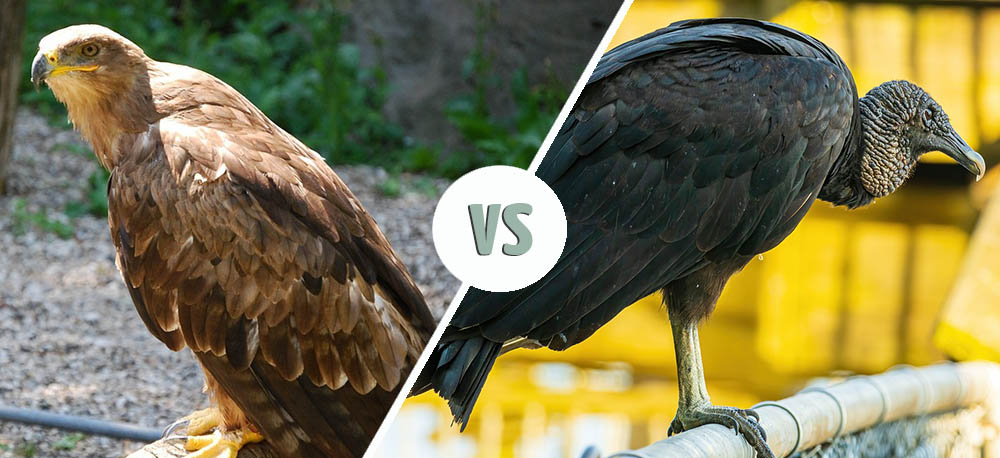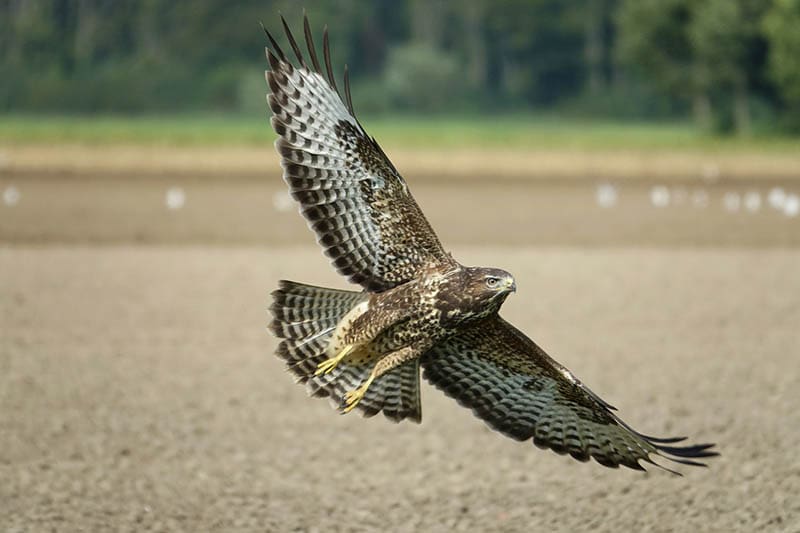What’re the Differences Between Buzzards and Vultures? (With Pictures)
Last Updated on

Have you ever found yourself confused between buzzards and vultures? Many people use these words interchangeably to define the same bird often. However, vultures are pretty different from buzzards in many ways.
For instance, a vulture is labeled as scavenging prey, while a buzzard is a unique bird of prey. Vultures have two different types, the Old World and New World vultures. On the other hand, all buzzards are usually the same but have some unique characteristics depending on the place they belong to.
In this exciting article, let’s explore how each of these varies.

Visual Differences

At a Glance
- Origin: North America, North Africa, and Eurasia
- Size: 40–58 centimeters
- Lifespan: 8 years
- Domesticated: No
- Origin: Asia, Europe, and Africa
- Size: 56–81 centimeters
- Lifespan: 10–30 years
- Domesticated: No

Buzzard Overview
Known to survive in any part of the world, buzzards are unique birds of prey found in deserts, forests, and grasslands. They may look like vultures but have different habits and preferences that make them unique. The red-tailed hawk is often considered a buzzard due to their many similarities.

Characteristics & Appearance
Buzzards have variable plumage, with some birds featuring heavy and brown markings, and a few predators have pure white plumage. They also come with rounded tails and broad wings. Unlike vultures, buzzards have a lot of feathers on their body and feature taloned feet. They are also significantly smaller than most vultures. There are almost 20–25 species of buzzards that exist right now. These birds are, unfortunately, slowly becoming scarce.
Buzzards have unique diet preferences. For instance, they like to feed on carcasses but don’t mind rabbits and small mammals. Also, unlike vultures, a buzzard likes to hunt for the perfect meal before settling down on a dead animal.
Another exciting fact about this bird is that all the buzzard pairs mate for a lifetime. They don’t change or swap their partners. Female buzzards are often heavier than males, so male buzzards are preferred as brilliant hunters.
What’s more, they don’t prefer forming flocks, but you may see them in groups while migrating. Unfortunately, buzzards have a weak sense of smell and feature soft feet.
These predators have sadly never been famous with falconers. This is because buzzards are considered pretty lazy to be taught to fly.

Uses
Buzzards are not too helpful. They are opportunistic predators that can help reduce the number of various varieties of prey. They usually feed on rodents, so people often welcome these birds to get rid of them.

Vultures Overview
Vultures are defined as scavenging birds of prey and are often found on every continent except for Antarctica and Australia. These long-necked birds are considered bad and dangerous due to their ugly eating habits. Vultures consume carrion, but they also clean the environment by eliminating carcasses and preventing the spreading of harmful diseases to humans and animals.
Below we have shared some interesting facts on vultures’ characteristics, appearances, and uses.

Characteristics & Appearance
Vultures look pretty different from most common birds. For instance, they have bald heads and broad wings that help them glide. They also have tiny feet and very prominent long lashes and eyebrows.
There are two kinds of vultures, Old World and New World. New World vultures have weak feet. This is because they don’t need them enough to catch their prey. On the other hand, Old World vultures come with solid feet to grasp their prey tightly. Old World vultures don’t have a strong sense of smell, unlike the New Old vultures.
New World vultures live in South America and North America. They live in various habitats, including lowland forests, deserts, and mountains. Old World vultures strive in Asia, Africa, and Europe. They prefer living in the warm countries of Europe and dry regions of Asia. You may spot Old World vultures in open areas and mountains but not in forests with heavy rainfalls.
These birds are also famous for having keen eyesight. Experts say vultures can quickly locate a three-foot dead animal from as far as four miles. And once they spot it, they start circling the dead animal.
Vultures are popular for consuming only dead animals (or carrion). That said, there is an exception. The Palm Nut vulture likes to consume oil palm fruit only.
These birds also follow a distinct mechanism of reproduction. Turkey vultures, for instance, come together to form a crowd on the ground and start hopping with their wings spread. This is their unique way of attracting their mates. Interestingly, both female and male vultures mate for many years, sometimes even throughout their lifetime. They often stay together for at least a year.

Uses
In the olden times, the various body parts of vultures were often mixed with minerals and plants to promote increased intelligence and good dreams. The mix was also helpful in enhancing clairvoyant abilities. Many people also used body parts to appease their ancestors.
However, today vultures are often considered a clean-up crew. They reduce the spread of diseases caused by dead animals and also curb bacteria. This is because the vital enzymes in their stomachs effectively kill microorganisms and toxins.

What Are the Differences Between Buzzards & Vultures?
- Vultures are scavengers, while buzzards are predators.
- The predators love to feed on live animals as well as dead ones as well. On the other hand, vultures mostly prefer dead animals only.
- Vultures have bald heads, which makes it hard for them to survive in cold areas. This is why they prefer staying in warm places. Buzzards have many feathers, so an area’s climate doesn’t affect its habitat.
- Vultures are mostly longer than most buzzards. They also have an impressive wingspan and a unique flight pattern than a predator. Buzzards come with capable and broad wings and have very different feet.
- There are almost 40 species of vultures, while buzzards have only 20–25. This is mainly because vultures have two different types.
- Both birds often keep their partners for life. However, when it comes to mating, they follow different methods.
- Unlike most vultures, buzzards have a weak sense of smell. Also, they have soft feet because they don’t use them often to grasp the prey.
- Vultures are often used to clean the remains of dead animals. Buzzards help kill rodents.

Final Thoughts
If you had been struggling to differentiate between vultures and buzzards, hopefully now you know how these birds vary from each other. Although they may look quite the same with somewhat similar diet and habitat preferences, their purpose of existence does differ. So, the next time you spot a vulture or a buzzard, hopefully, you will be successful in categorizing the bird correctly.
Featured Image Credit: (L) Ortrun Lenz, Pixabay | (R) Scott, Pixabay
About the Author Jeff Weishaupt
Jeff is a tech professional by day, writer, and amateur photographer by night. He's had the privilege of leading software teams for startups to the Fortune 100 over the past two decades. He currently works in the data privacy space. Jeff's amateur photography interests started in 2008 when he got his first DSLR camera, the Canon Rebel. Since then, he's taken tens of thousands of photos. His favorite handheld camera these days is his Google Pixel 6 XL. He loves taking photos of nature and his kids. In 2016, he bought his first drone, the Mavic Pro. Taking photos from the air is an amazing perspective, and he loves to take his drone while traveling.
Related Articles:
Monocular vs Telescope: Differences Explained (With Pictures)
10 Types of Hummingbirds in Arkansas (With Pictures)
8 Types of Hummingbirds in Nebraska (With Pictures)
5 Types of Hummingbirds in Idaho (With Pictures)
3 Types of Hummingbirds in Mississippi (With Pictures)
8 Types of Hummingbirds in Kansas (With Pictures)
5 Types of Hummingbirds in West Virginia (With Pictures)
5 Types of Hummingbirds in Ohio (With Pictures)
